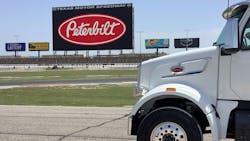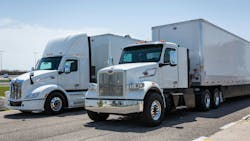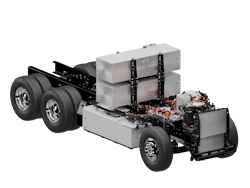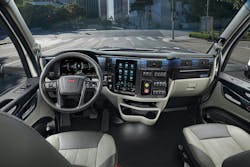Peterbilt’s EV-olution continues: Launches vocational 567EV, next-gen 579EV
Key takeaways:
- Peterbilt has launched the 567EV and next-gen 579EV, showcasing its commitment to electric vehicle technology in heavy-duty trucking.
- The new ePowertrain offers increased range, multiple power options, and customization for various vocational applications.
- Both models are designed to operate like diesel trucks, enhancing driver comfort and facilitating the transition to electric vehicles.
ANAHEIM, California—Leaning on what it learned from its first heavy-duty battery electric truck, Peterbilt is rolling out its first vocational EV and updating its flagship Class 8 electric tractor.
Equipped with Paccar’s new ePowertrain, the new Model 567EV and next-generation Model 579EV offer increased range and advanced technology for fleets seeking to reduce emissions and enhance uptime.
“The completely new ePowertrain is the heart of the new EV models and a culmination of five-plus years of arduous testing and developing a battery-electric platform befitting a Peterbilt,” Erik Johnson, the OEM’s assistant GM of sales and marketing, said during a sneak peek of the new trucks in Texas on April 14.
Peterbilt (and OEM sibling Kenworth) used the trucking industry’s largest gathering of alt-fuel-minded transportation leaders to debut the Model 567EV and a next-generation version of its Model 579EV on-highway tractor.
In the five years since the first 579EV debuted, Peterbilt engineers and executives have gained valuable insights into what makes a successful battery-electric operation. Scott Newhouse, Peterbilt’s chief engineer, said that the OEM understands how to better accessorize electric truck powertrains, for example.
“We’ve taken those learnings and put them back into the design,” he told industry media in advance of the truck’s launch. “We run them through some additional testing scenarios to take care of those things.”
Other than the quiet motor and less vibration, the next generation of Peterbilt’s EV trucks actually feel like trucks—not the more zippy and basic car-like character of years ago. “If you’re an operator, it operates like you’d expect a diesel to," Newhouse said.
New Paccar ePowertrain offers versatility
The two new Class 8 EVs feature the Paccar ePowertrain, a new electric vehicle architecture that can be adapted to various models and applications.
“We build custom trucks for people,” Johnson said during a media briefing about the new EVs at Peterbilt’s Denton, Texas, production plant earlier this month. “Every truck you saw down the line is different from every other truck that we’re building this year—completely custom. This new powertrain gives us flexibility of building different bodies, different customer expectations on the same platform.”
Before the truck launch, Peterbilt leaders shared some of the electric powertrain features:
- Midship-mounted eMotor: Dual electric motors and integrated 3-speed transmission offer seamless shifting without losing torque.
- Multiple power options can benefit different applications and needs, offering up to 605 hp and 1,850 lb.-ft. of torque.
- Lithium iron phosphate battery (LFP) chemistry
- Selectable three-stage regenerative braking
- Flexible architecture allows for integration with existing suspensions.
The trucks can support wheelbases of 190 inches or longer and applications with a gross combined weight of up to 82,000 lb.
Next-generation Peterbilt Model 579EV specs
- Paccar ePowertrain: Midship-mounted eMotor with dual electric motors and integrated 3-speed transmission
- Power/torque options: 470 hp, 540 hp, 605 hp
- Torque: 1,850 lb.-ft
- Battery options: 250 kWh, 375 kWh, 500 kWh
- Maximum range: 200 miles
- Charging: 350 kW DC charging can reach 80% in ~90 minutes
- PTO power options: ePTO rated 25 kW or 150 kW
- GVWR: 82,000 lb.
- Truck class: Class 8
- Vehicle applications: Regional haul, drayage, delivery
About the next-generation Model 579EV
Based on its diesel-powered flagship Model 579, the next-generation Model 579EV is designed for regional haul and drayage applications.
Mitesh Naik, Peterbilt’s product planning and strategy director, said the updated 579EV is a good way for fleets to “dip your toe in” the battery-electric pool. “Run a few vehicles, keep up with the technology,” he suggested.
And with charging infrastructure for larger operations taking years to plan and build, Naik said it is essential for fleets to think ahead. “It’s about planning ahead for what the future brings,” he said. “In my opinion, that’s why fleets should be interested—whether they’re in California or not.”
Peterbilt created an exclusive 579EV grille with a distinctive pattern and splayed grille bars with blue accents. The hood has side panels with bright bezels and blue accents. The interior design features laser-etched trim panels and gray stitching with an EV-exclusive interior.
See also: Peterbilt’s new leader relies on partnerships and patience amid market uncertainty
Peterbilt 579EV specific features include:
- Three battery capacity options
- Maximum range of 200 miles.
- Up to 350kW DC charging that enables 80% charge in just over 90 minutes
- Safety enhancements, including a new electronic parking brake (EPB) and standard Bendix Fusion Stop & Auto-Go Advanced.
- Driver-focused ergonomics
- LED lighting
New Peterbilt Model 567EV specs
- Paccar ePowertrain: Midship-mounted eMotor with dual electric motors and integrated 3-speed transmission
- Power/torque options: 470 hp, 540 hp, 605 hp
- Torque: 1,850 lb.-ft
- Battery options: 250 kWh, 375 kWh, 500 kWh, 625 kWh
- Maximum range: 250 miles
- Charging: 350 kW DC charging can reach 80% in ~90 minutes
- GVWR: 82,000 lb.
- Truck class: Class 8
- Vehicle applications: Vocational, dump, utility, roll-on-roll-off, equipment haul
All-new Model 567EV
The all-new Model 567EV is designed for vocational applications, including dump trucks, utility trucks, and equipment haulers.
“I think a lot of it centers around ESG initiatives for companies combined with what we see in the regulatory space,” Newhouse said. “Hypothetically, if I’m a concrete mixer operator somewhere in California, then I’m very interested in a 567 battery electric.”
He said vocational operations like that are the “perfect use case” for heavy-duty EVs. “The trucks come home every night and get charged up and sent out again to do their job,” he explained. “With the 567 having a dedicated battery pack for the body, in essence, the mixer does its job, then comes home.”
With a blue-accented crown and grille, the 567EV features EV-exclusive panels on the sides of the hood, giving a modern look to the rugged truck body. The added elements deliver contemporary styling while maintaining its rugged presence.
Other Model 567EV features include:
- Four distinct battery capacity options with a maximum range of 250 miles in full truck and tractor configurations
- Furnished-by-owner ePTO options rated at 25kW or 150kW
- Configurable PTO controls and switches
- Industry standard body lighting connections
- Customizable frame layout options
Peterbilt’s design and innovation
Peterbilt's common design philosophy is reflected in these two new EV models. Both the next-generation Model 579EV and new 567EV feature:
- Paccar ePowertrain
- EV-specific digital driver display with performance and charging data
- SmartLINQ integration indicating energy usage, location, and range
- Configurable powertrain and cabin preconditioning
- Configurable charge start times to take advantage of lower electricity rates
- Electronic Park Brake system electronically controlled brakes with full software integration
About Peterbilt’s new EV SmartDisplay
A new SmartDisplay—a 13-in. infotainment touchscreen with a control dial—is available in both new EVs. Drivers have quick access to essential functions such as HVAC controls and AM/FM/satellite radio. It also features advanced productivity applications, including vehicle health monitoring, navigation, and a dealer locator. Beginning in 2026, Virtual Vehicle, an online app marketplace, will be added.
How Peterbilt and Pacaar charging works
Peterbilt’s parent company, Paccar (which also used ACT Expo to introduce new electric Kenworth trucks), has developed charging and EV partnerships aimed at helping fleets deploy zero-emission vehicles.
Dealers have a lineup of AC and DC chargers available through Paccar Parts, including options with capacities of up to 350kW. The company is also partnered with QMerit and Schneider Electric for charging infrastructure planning and installation.
About the Author
Josh Fisher
Editor-in-Chief
Editor-in-Chief Josh Fisher has been with FleetOwner since 2017. He covers everything from modern fleet management to operational efficiency, artificial intelligence, autonomous trucking, alternative fuels and powertrains, regulations, and emerging transportation technology. Based in Maryland, he writes the Lane Shift Ahead column about the changing North American transportation landscape.




